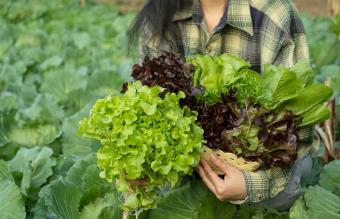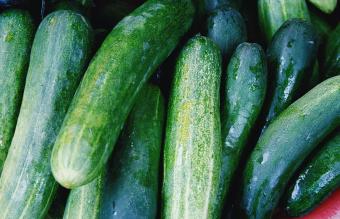
Haven't started planting yet? Don't worry. These crops grow fast. Some of them grow so quickly that you can even get two harvests out of them. Check out our list of veggies that grow in just a few months.
Beets

Beets are one of the fastest-growing vegetables, requiring only 55 to 70 days to mature. Plant them in spring (mid-June harvest) and again in late July (fall harvest). You can also plant successive crops a week apart for bigger production.
Don't toss the leaves, since you can cook them as tasty greens.
Related: Timing Your Garden: When It's Too Late to Start Planting
Cucumbers

Cucumbers are best grown vertically in full sunlight. The cucumbers will mature in 50 to 70 days, depending on the variety. Pick cucumbers before they're fully grown for the best flavor and crispness. They grow very quickly, so plan to harvest them daily.
If cucumber production slows down, feed three tablespoons of Epsom salt sprinkled on ground to encircle the plant base. Leave about three inches between plant and the Epsom salt.
Green Beans

You can grow green beans as a bush or pole bean. Pole beans will provide a higher yield as long as the temperatures remain below 98°F. Beans will temporarily stop producing when the temperature becomes too high but will resume as soon as the temperatures lower. Make sure you check beans daily for harvesting once they get to about 45 days, since they grow very quickly — the more you harvest, the more they produce.
Pole beans usually produce beans for a longer season than bush beans.
Lettuce

Leaf lettuce varieties and butterhead lettuces are some of the fastest-growing vegetables you can plant. They only take 45 to 55 days to mature. However, you can harvest them any time, as the baby leaves are tender, nutritious, and flavorful. In full-grown plants, harvest the outer leaves first to allow the plant to continue to produce leaves.
While most lettuces prefer spring to early summer and late summer to fall weather, some varieties are slow bolting. You can also grow lettuce year-round indoors as long as the plants receive adequate light, up to 10 hours (grow lights will help).
Okra

Okra is very easy to grow and a huge producer. It matures in 50-65 days. Leave at least two feet between the plants since they have a large spread. Harvesting okra daily will keep the plants producing, and don't allow the pods to grow larger than three to four inches long, or they will be tough.
Plant lettuce between each plant to protect the lettuce plants from harsh summer sun and heat.
Green Onions

If you need a really fast-growing vegetable, opt for green onions. You can use a container to grow these onions. Plant from seed or transplant onion sets. Green onions mature within 20-30 days of planting the seeds.
Radishes

Radishes grow very quickly. Some varieties are ready to harvest within 22 days of planting, while other varieties may take up to 70 days. Choose the quick-growing varieties and plant succession crops every one to two weeks to ensure you have an ongoing crop throughout the growing season. Grow radishes from early spring to mid-summer and again at the end of summer into fall.
Spinach

You can grow spinach in spring and early summer and again in late summer and fall. It has a short maturation range of only 25-45 days. The New Zealand variety can be grown through hot summer days without bolting. Harvest leaves by cutting no more than two inches from the ground to encourage regrowth
Tomatoes

Tomatoes are easy to grow. Some only take 50 days to maturity, while others require as much as 70 days. If you don't have time to grow from seed inside your home to transplant later, you can purchase plants. Transplanted tomato plants make for a faster harvest from the time you transplant them to fruiting.
Zucchini and Summer Squash

Zucchini and summer squash are very easy to grow. Both are extremely prolific producers, with zucchini squash growing as much as two to three inches per day. Zucchini reaches maturity within 35-55 days of planting seeds, and summer squash reaches maturity within 40-55 days of planting seeds.
Pick zucchini and summer squash daily to encourage the plants to continue to produce.
Discover Which Fruits and Vegetables Grow Quickly
If you're looking for a quick harvest, these veggies pay off big time. And with so many culinary staples, you can enjoy fresh produce all spring, summer, and fall.







